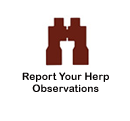
A Guide to the Amphibians
and Reptiles of California

Notes on the Taxonomic Lists

| This web site was created to promote an appreciation and understanding of the amazing diversity of reptiles and amphibians occurring in California, and their natural habitats, by illustrating them in their many forms. To accomplish this in an organized manner it needs a list of all of the known forms of reptiles and amphibians currently or recently occurring within the state of California and in nearby coastal waters, including some introduced species with well-established reproducing populations, and formerly-occurring species that may now be extirpated from the state. The list used here is mostly based on the most recent list of scientific and common names published by experts in this field. This site intends only to report the current standard nomenclature and taxonomy, not to present personal opinions, but there are differing views on the subject, so I have had to make some choices that not everyone will agree with. I will attempt to document these differing views as well as I can. As a consequence of using the latest taxonomy, many of the names here differ significantly from long-accepted nomenclature used in most books and publications and with the California Department of Fish and Game list, which codifies the laws regarding California's herps. So I have tried to indicate the older and often more established names also. There is no one globally-accepted authority on reptile and amphibian taxonomy that I can follow here, but beginning in 2025 I've been modifying my list based on these two recently-published sources which are sometimes quite different: * The 2025 Hansen and Shedd California Field Guide ((Hansen, Robert W. and Shedd, Jackson D. California Amphibians and Reptiles. [Princeton Field Guides.] Princeton University Press, 2025) * The 9th edition of the SSAR Checklist of the Standard English Names of Amphibians & Reptiles (Nicholson, K. E. ed. 2025. Scientific and Standard English Names of Amphibians and Reptiles of North America North of Mexico, with Comments Regarding Confidence in Our Understanding. Ninth Edition. Society for the Study of Amphibians and Reptiles. 87pp.) which you can download here. The SSAR has also restored their online database names list which is found at CNAH.org. Both of these sources make some fairly radical changes to the long established taxonomy of several California species so I will not make all of these changes immediately. I will wait to see how these changes are accepted. Scientific and common names are basically opinions. I try to use the opinions of respected authorities rather than my own, but sometimes I have to make a choice whether or not to use a new name, or keep with the old one until the new one is widely accepted. Any choice I make invariably upsets somebody, including myself. I use some new taxonomy that even I don't believe should have been adopted yet, but I follow just to keep up with the experts. In some occasions, they have adopted the changes too soon and the taxonomy reverts back to what it was years ago, and I once again have to change my list. The nomenclature used here is not necessarily definitive. It is a challenge to keep up with the continual changes in scientific nomenclature and common names. Classifications keep changing in order to more accurately reflect evolutionary relationships.There is frequent disagreement about the concept of what determines a biological species or subspecies (or even the validity of subspecies at all) and how to classify and name them. The science of naming and classifying animals (taxonomy or systematics) is constantly evolving and there are often conflicting interpretations. Recent widespread DNA analysis has identified many new species and led to new classifications of species, and this has changed the nomenclature considerably. Since there is no one list made by an organization that is unanimously accepted as the final authority on nomenclature (as there is for birds) herpers are left with a confusing variety of multiple common and scientific names. ---------------------------------------------------------------------------------------------------------------------------------------------------------------- Besides this list and the SSAR and Hansen and Shedd lists referenced above, you might want to look at the taxonomy used by other sources, including these: The California Department of Fish and Wildlife. The CDFW uses a list of herps in its annual fishing regulations in the sections governing the take of reptiles and of amphibians which is important to know if you plan to take herps. Their list sometimes differs from the others. You can see my interpretation of their list here along with links to the CDFW regulations and CDFW site. Stebbins, Robert C., and McGinnis, Samuel M. Field Guide to Amphibians and Reptiles of California: Revised Edition (California Natural History Guides) University of California Press, 2012. |
| "…I began to see that science was neither the best nor the only valid way to order and name the living world. Instead, I realized that the ordering and naming of life was and always had been, at its heart, something much more democratic, subversive to the dominion of science even, and much more interesting. I eventually came to see that science itself might be undermining the very thing it sought to perfect: humanity's understanding of life. Even more unexpected, I realized that the thoroughly modern, entirely evolutionary new science of taxonomy was actually helping regular folks everywhere to become more and more disconnected from living things - a tragedy that has made it possible for species after species to disappear around the world with hardly anyone noticing or much caring." Carol Kaesuk Yoon. Naming Nature - The Clash Between Instinct and Science. W. W. Norton & Company, Inc. 2009. |
Return to the Top
© 2000 -